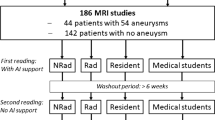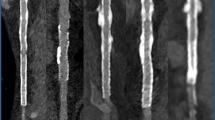Abstract
Objectives
To evaluate in-stent lumen visibility of 27 modern and commonly used coronary stents (16 individual stent types, two stents at six different sizes each) utilising a third-generation dual-source CT system.
Methods
Stents were implanted in a plastic tube filled with contrast. Examinations were performed parallel to the system's z-axis for all stents (i.e. 0°) and in an orientation of 90° for stents with a diameter of 3.0 mm. Two stents were evaluated in different diameters (2.25 to 4.0 mm). Examinations were acquired with a collimation of 96 × 0.6 mm, tube voltage of 120 kVp with 340 mAs tube current. Evaluation was performed using a medium-soft (Bv40), a medium-sharp (Bv49) and a sharp (Bv59) convolution kernel optimised for vascular imaging.
Results
Mean visible stent lumen of stents with 3.0 mm diameter ranged from 53.3 % (IQR 48.9 − 56.7 %) to 73.9 % (66.7 − 76.7 %), depending on the kernel used at 0°, and was highest at an orientation of 90° with 80.0 % (75.6 − 82.8 %) using the Bv59 kernel, strength 4. Visible stent lumen declined with decreasing stent size.
Conclusions
Use of third-generation dual-source CT enables stent lumen visibility of up to 80 % in metal stents and 100 % in bioresorbable stents.
Key Points
• Blooming artefacts impair in–stent lumen visibility of coronary stents in CT angiography.
• CT enables stent lumen visibility of up to 80 % in metal stents.
• Stent lumen visibility varies with stent orientation and size.
• CT angiography may be a valid alternative for detecting in-stent restenosis.





Similar content being viewed by others
References
Buuren F (2010) 25. Bericht über die Leistungszahlen der Herzkatheterlabore in der Bundesrepublik Deutschland. Der Kardiol 4:502–508
Dangas GD, Claessen BE, Caixeta A et al (2010) In-stent restenosis in the drug-eluting stent era. J Am Coll Cardiol 56:1897–1907
Peberdy MA, Donnino MW, Callaway CW et al (2013) Impact of percutaneous coronary intervention performance reporting on cardiac resuscitation centers: a scientific statement from the American Heart Association. Circulation 128:762–773
Maintz D, Seifarth H, Raupach R et al (2006) 64-slice multidetector coronary CT angiography: in vitro evaluation of 68 different stents. Eur Radiol 16:818–826
Maintz D, Burg MC, Seifarth H et al (2009) Update on multidetector coronary CT angiography of coronary stents: in vitro evaluation of 29 different stent types with dual-source CT. Eur Radiol 19:42–49
Seifarth H, Ozgün M, Raupach R et al (2006) 64- Versus 16-slice CT angiography for coronary artery stent assessment: in vitro experience. Invest Radiol 41:22–27
Pugliese F, Weustink AC, Van Mieghem C et al (2008) Dual source coronary computed tomography angiography for detecting in-stent restenosis. Heart 94:848–854
Krüger S, Mahnken AH, Sinha AM et al (2003) Multislice spiral computed tomography for the detection of coronary stent restenosis and patency. Int J Cardiol 89:167–172
Donati OF, Burg MC, Desbiolles L et al (2010) High-pitch 128-slice dual-source CT for the assessment of coronary stents in a phantom model. Acad Radiol 17:1366–1374
Rief M, Zimmermann E, Stenzel F et al (2013) Computed tomography angiography and myocardial computed tomography perfusion in patients with coronary stents: prospective intraindividual comparison with conventional coronary angiography. J Am Coll Cardiol 62:1476–1485
Seifarth H, Raupach R, Schaller S et al (2005) Assessment of coronary artery stents using 16-slice MDCT angiography: evaluation of a dedicated reconstruction kernel and a noise reduction filter. Eur Radiol 15:721–726
Pache J, Kastrati A, Mehilli J et al (2003) Intracoronary stenting and angiographic results: strut thickness effect on restenosis outcome (ISAR-STEREO-2) trial. J Am Coll Cardiol 41:1283–1288
Boston Scientific: OMEGATM Platinum Chromium Coronary Stent System. http://www.bostonscientific-international.com/Device.bsci?page=HCP_Overview&navRelId=1000.1003&method=DevDetailHCP&id=10144661&pageDisclaimer=Disclaimer.ProductPage,Disclaimer.ReservedForMedProfs
Ormiston JA, Serruys PW, Regar E et al (2008) A bioabsorbable everolimus-eluting coronary stent system for patients with single de-novo coronary artery lesions (ABSORB): a prospective open-label trial. Lancet 371:899–907
Nieman K, Serruys PW, Onuma Y et al (2013) Multislice computed tomography angiography for noninvasive assessment of the 18-Month performance of a novel radiolucent bioresorbable vascular scaffolding device: the ABSORB Trial (a clinical evaluation of the bioabsorbable everolimus eluting coronary stent). J Am Coll Cardiol 62:1813–1814
Abbott Vascular: JOSTENT GRAFTMASTER with HYDREX Coating System INSTRUCTIONS FOR USE. http://www.abbottvascular.com/static/cms_workspace/pdf/ifu/humanitarian_use/IFU_Jostent_Graftmaster_OTW.pdf
Carrabba N, Schuijf JD, de Graaf FR et al (2010) Diagnostic accuracy of 64-slice computed tomography coronary angiography for the detection of in-stent restenosis: a meta-analysis. J Nucl Cardiol 17:470–478
Sun Z, Almutairi AMD (2010) Diagnostic accuracy of 64 multislice CT angiography in the assessment of coronary in-stent restenosis: a meta-analysis. Eur J Radiol 73:266–273
André F, Müller D, Korosoglou G et al (2014) In-vitro assessment of coronary artery stents in 256-multislice computed tomography angiography. BMC Res Notes 7:38
Acknowledgments
This work was supported by the Comprehensive Heart Failure Center Würzburg. The scientific guarantor of this publication is Tobias Gassenmaier. The authors of this manuscript declare relationships with the following companies: Thomas Allmendinger and Thomas Flohr: employees of Siemens Healthcare. The authors state that this work has not received any funding. No complex statistical methods were necessary for this article. Institutional Review Board approval was not required because no human subjects were involved in this in vitro study. Methodology: experimental.
Author information
Authors and Affiliations
Corresponding author
Additional information
Tobias Gassenmaier and Nils Petri have equal contribution
Rights and permissions
About this article
Cite this article
Gassenmaier, T., Petri, N., Allmendinger, T. et al. Next generation coronary CT angiography: in vitro evaluation of 27 coronary stents. Eur Radiol 24, 2953–2961 (2014). https://doi.org/10.1007/s00330-014-3323-6
Received:
Revised:
Accepted:
Published:
Issue Date:
DOI: https://doi.org/10.1007/s00330-014-3323-6




